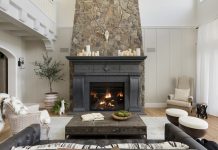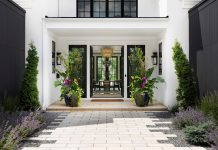
If you’ve ever paged through The New York Times Magazine on Sundays, you’ve probably seen the advertisements for Gudrun Sjödén’s women’s clothing. The Swedish designer, who started her company 40 years ago, creates colorful layering pieces for women of all ages, shapes, and sizes in bright, bold colors, and lively stripes and patterns abstracted from nature, out of organic and sustainably sourced materials.
St. Paul psychologist, author and artist Rachel Awes, whose artwork is as vibrant as Sjödén’s clothing—and which Awes wears with enthusiasm—was an exuberant model in one of the magazine ads. Awes also recently participated in the fashion show on the grounds of the American Swedish Institute (ASI), which is hosting the first large-scale U.S. exhibition of Sjödén’s work, “Gudrun Sjödén — A Colourful Universe.”

Included in the exhibition, which many visitors many not be aware of, are examples of Sjödén’s home décor and furnishings, which include hand-painted tableware, tablecloths and napkins, rugs and door mats, pillows and seat covers, curtains and towels, and bedding in an array of heavenly hues, perky patterns, and even black, gray, and white colorways sure to please minimalists. These items are only available via the online store, but a sampling of Sjödén’s homewares and clothing are available in a special section of the American Swedish Institute’s museum store during the exhibition, which runs through October 28.

The exhibition itself is a delight. It’s the final show in ASI’s 2018 exploration of “The Handmade,” which focused on master makers, the work they create and the global movements they have inspired. “Gudrun Sjödén— A Colourful Universe,” however, is as much about Sjödén’s artistic inclinations, innovations as a global entrepreneur, and the impact of a woman-run company as it is her clothing and décor.

One of the company’s acclaimed designers, Wanja Djanaieff, helped create the playful exhibition, which celebrates color, the company’s green approach to sourcing and design, and Sjödén’s impact as a water colorist, designer and entrepreneur. In the Osher Gallery, the connections between Sjödén’s watercolors and textile patterns are clear: The gallery includes a Brobdingnagian box of “watercolors” below an array of giant “paintbrushes,” while across the room outfits are layered on top of paintbrush-figured mannequins.

Throughout the Turnblad Mansion, Djanaieff, inspired by the Swedish Maypole tradition, used the maypole shape as mannequins. Outfits in the galleries are arranged to explore the company’s creative and production processes, its history, and the ways in which Sjödén and her team draw inspiration from the handcraft traditions of countries including Japan, Mexico, and India.

Sitting areas throughout the mansion are festooned with Sjödén’s textiles, table décor, cushion covers, and pillows. Engaging and welcoming, these spaces invite visitors to stay a while and luxuriate in Gudrun Sjödén’s colorful universe.


















